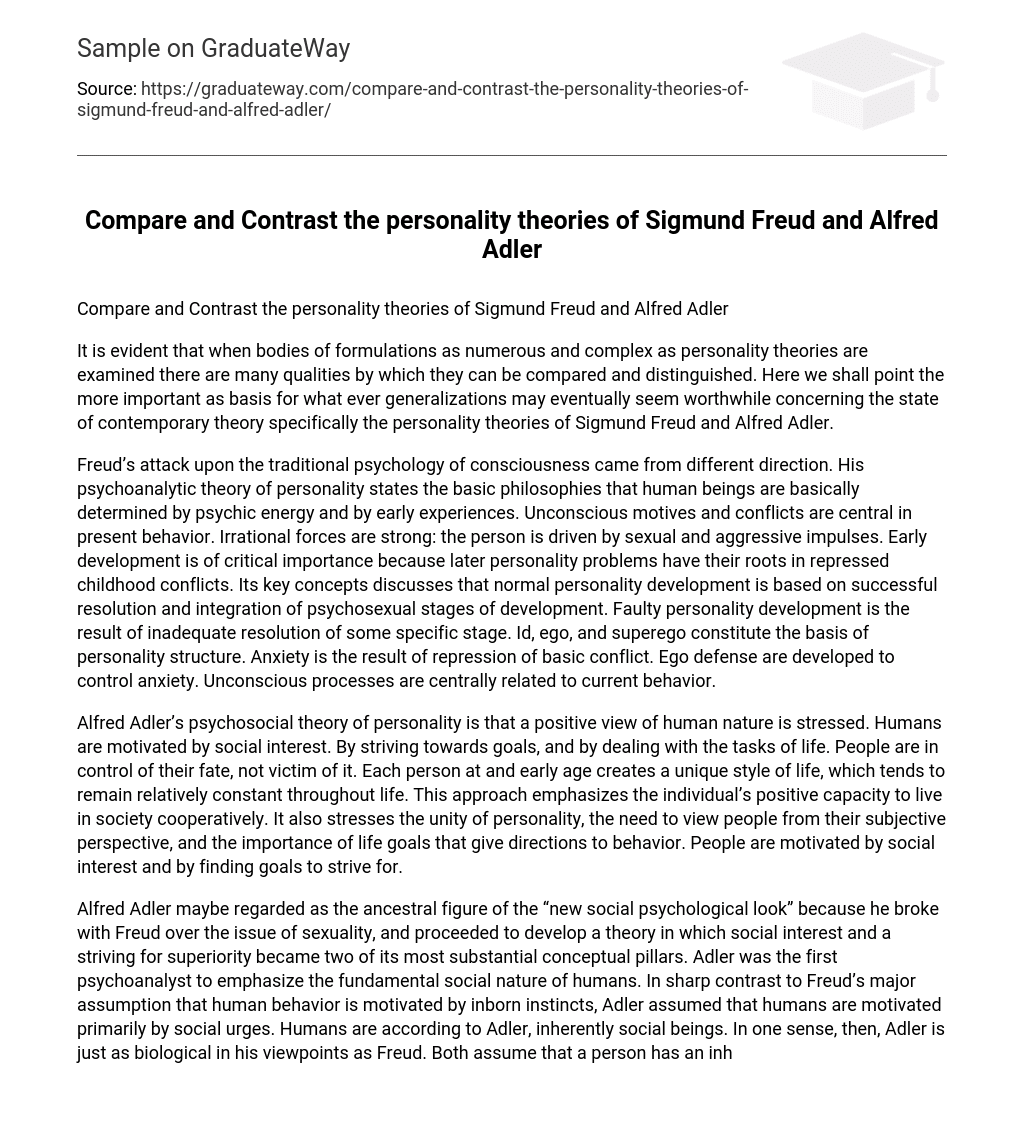It is evident that when examining formulations as numerous and complex as personality theories, there are many qualities by which they can be compared and distinguished. In this article, we will highlight the most important qualities as a basis for any generalizations that may eventually seem worthwhile regarding the state of contemporary theory, specifically the personality theories of Sigmund Freud and Alfred Adler.
Freud’s attack on traditional psychology of consciousness came from a different direction. His psychoanalytic theory of personality states that human beings are primarily determined by psychic energy and early experiences. Unconscious motives and conflicts play a central role in present behavior, where irrational forces such as sexual and aggressive impulses drive the person. Early development is critical because later personality problems have their roots in repressed childhood conflicts.
The key concepts of Freud’s theory suggest that normal personality development is based on the successful resolution and integration of psychosexual stages of development, while faulty personality development results from inadequate resolution at specific stages. The id, ego, and superego constitute the basis of personality structure.
Anxiety arises as a result of repression caused by basic conflict, with ego defenses developed to control anxiety. Unconscious processes are centrally related to current behavior.
Alfred Adler’s psychosocial theory of personality stresses a positive view of human nature. Humans are motivated by social interest, striving towards goals, and dealing with life tasks. People are in control of their fate and not victims of it. Each person creates a unique style of life at an early age that tends to remain relatively constant throughout their lifetime.
This approach emphasizes the individual’s positive capacity to live cooperatively in society, stressing the unity of personality and the importance of viewing people from their subjective perspective. Additionally, it highlights the significance of life goals that give direction to behavior. People are motivated by social interest and finding goals to strive for.
Alfred Adler may be regarded as the ancestral figure of the new social psychological look” because he broke with Freud over the issue of sexuality and proceeded to develop a theory in which social interest and a striving for superiority became two of its most substantial conceptual pillars. Adler was the first psychoanalyst to emphasize the fundamental social nature of humans. In sharp contrast to Freud’s major assumption that human behavior is motivated by inborn instincts, Adler assumed that humans are motivated primarily by social urges. According to Adler, humans are inherently social beings.
In one sense, then, Adler is just as biological in his viewpoints as Freud. Both assume that a person has an inherent nature that shapes his or her personality. However, Freud emphasized sex while Adler stressed social interest. This emphasis upon the social determinants of behavior that had been overlooked or minimized by Freud is probably Adler’s greatest contribution to psychological theory.
Adler’s second major contribution to personality theory is his concept of the creative self. Unlike Freud’s ego, which consists of a group of psychological processes serving the ends of inborn instincts, Adler’s self is highly personalized subjective system that interprets and makes meaningful actions that aid in fulfilling a person’s unique style of life.
A third feature of Adler’s psychology that sets it apart from classical psychoanalysis is its emphasis upon the uniqueness of personality. Each person is considered by Adler as having their own unique configuration of motives, traits, interests and values; every act performed by them bears their own distinctive style-of-life stamp.
Adler’s theory minimizes sexual instinct which played an almost exclusive role in early theorizing done by Freud on dynamics behavior; he added other significant voices such as humans being primarily motivated socially rather than sexually and inferiorities not being limited only to sexual domains but extending towards all facets both physical and psychological.
Finally, Adler considered consciousness to be the center of personality, making him a pioneer in the development of an ego-oriented psychology. Humans are conscious beings; they are ordinarily aware of the reasons for their behavior and conscious of their inferiorities and goals for which they strive. Humans are self-conscious individuals capable of planning and guiding their actions with full awareness towards self-realization. This is in complete antithesis to Freud’s theory, which had virtually reduced consciousness to the status of nonentity – a mere froth floating on the great sea of the unconscious.
References:
Journal Articles
Caws, P. (2005). Analysis with Freud: Psychoanalytic Criticism. Sartre Studies.
International 11: 166+.
Parrott, L. (1992). Earliest Recollection and Birth Order: Two Adlerian Exercises.
Teaching of Psychology, 19, 40+
Pollak, R. (1998). Psychoanalysis and Public Opinion. The Nation, 267(1), 1-14.
Polanski, P. (2002) explored spiritual beliefs in relation to Adlerian theory.
Counseling and Waves 46: 127+.





